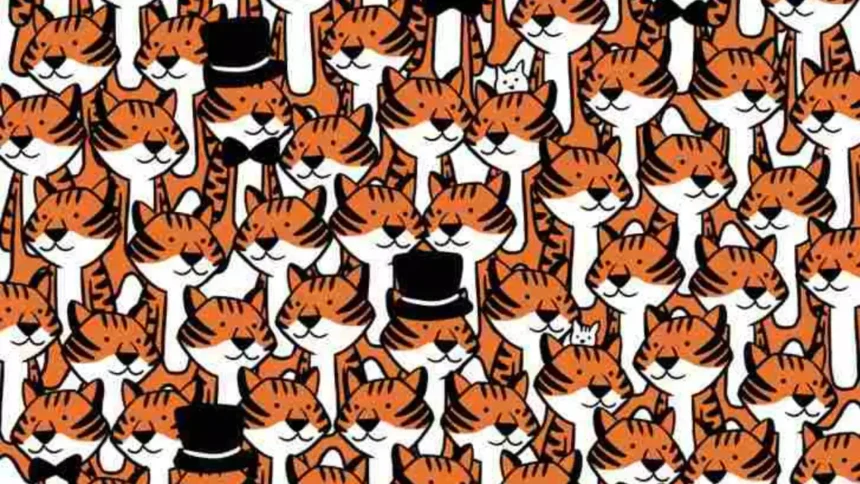In the realm of cognitive puzzles and perceptual conundrums, optical illusions stand as captivating enigmas that both baffle and intrigue the human mind.
These visual phenomena often challenge our perception of reality, prompting us to question the very fabric of what we see.
Among the myriad optical illusions that have fascinated researchers and enthusiasts alike, one particular puzzle has captured widespread attention: the elusive task of spotting cats hiding among tigers within a mere 10-second timeframe.
What’s more, it’s been purported that only individuals with a high IQ possess the keen discernment necessary to unravel this perplexing riddle.
But what lies at the intersection of optical illusions and intelligence? Let’s embark on a journey to unravel this enigmatic puzzle.
The Fascination of Optical Illusions

Before delving into the intricacies of the feline-filled illusion, it’s imperative to grasp the allure of optical illusions themselves.
These visual phenomena exploit the complexities of human perception, capitalizing on the brain’s propensity to interpret visual stimuli in intriguing and often misleading ways.
From the renowned works of M.C. Escher to the contemporary digital marvels sweeping social media platforms, optical illusions have captivated audiences for centuries, transcending cultural and generational boundaries.
At the heart of optical illusions lies the intricate interplay between our sensory perceptions and cognitive processes.
These illusions exploit various perceptual mechanisms, including size constancy, color contrast, and gestalt principles, to deceive the mind and create baffling visual paradoxes.
By manipulating factors such as perspective, shading, and spatial relationships, optical illusions challenge our brains to reconcile conflicting visual information, often leading to surprising and confounding outcomes.
Unraveling the Cat and Tiger Conundrum
Enter the perplexing puzzle of spotting cats concealed among a sea of tigers—a challenge that has garnered widespread attention across the digital landscape.
The premise is simple yet deceptively complex: within a densely populated image of tigers, a handful of elusive felines lurk in plain sight, awaiting detection by astute observers.
The catch? Participants are granted a mere 10 seconds to identify as many hidden cats as possible—a task purportedly reserved for individuals with a high IQ.
The allure of this optical illusion lies not only in its visual intrigue but also in its tantalizing suggestion of a link between perceptual prowess and intellectual aptitude.
By framing the challenge within the context of IQ—a metric traditionally associated with cognitive ability and problem-solving skills—the illusion adds an additional layer of mystique, inviting participants to ponder the implications of their perceptual acuity on measures of intelligence.
Exploring the Science Behind Perception and Intelligence
To understand the purported connection between optical illusions and IQ, it’s essential to explore the underlying mechanisms of perception and intelligence.
Perception, the process by which we interpret and make sense of sensory information, plays a pivotal role in our ability to navigate the world around us.
From recognizing faces to discerning objects in our environment, perception shapes our understanding of reality and influences our cognitive processes.
Intelligence, on the other hand, encompasses a broad spectrum of cognitive abilities, including problem-solving, critical thinking, and abstract reasoning.
While traditional measures of intelligence, such as IQ tests, aim to quantify these abilities through standardized assessments, the relationship between perceptual prowess and intellectual aptitude remains a topic of ongoing debate among psychologists and neuroscientists.
The Role of Pattern Recognition and Cognitive Flexibility
At the heart of the cat and tiger illusion lies the fundamental cognitive process of pattern recognition—a cornerstone of human perception and cognition.
Our brains are adept at identifying familiar patterns and distinguishing meaningful information from background noise—a skill that underlies our ability to detect hidden figures within complex visual scenes.
Moreover, the illusion taps into our capacity for cognitive flexibility—the ability to adapt our thinking and problem-solving strategies in response to changing stimuli.
As participants scan the image in search of hidden cats, they must quickly adjust their attention and perceptual focus, shifting between global and local processing modes to extract relevant information from the visual array.
Debunking the Myth of IQ and Optical Illusions
While the notion that only individuals with a high IQ can spot the hidden cats may seem compelling, it’s essential to approach such claims with a healthy dose of skepticism.
Intelligence is a multifaceted construct that defies simple categorization, encompassing a diverse array of cognitive abilities and aptitudes.
While some individuals may excel in traditional measures of intelligence, others may possess exceptional talents in areas such as creativity, emotional intelligence, or spatial reasoning.
Furthermore, the ability to spot hidden figures within optical illusions is not necessarily indicative of overall intelligence.
While certain cognitive skills, such as pattern recognition and attentional control, may contribute to success in such tasks, they represent only a subset of the myriad abilities that comprise human intelligence.
The Influence of Experience and Practice
It’s also worth noting the significant role that experience and practice play in shaping perceptual expertise.
Individuals who frequently engage with visual puzzles and cognitive challenges may develop heightened perceptual skills over time, enabling them to excel in tasks that require rapid pattern recognition and visual processing.
Moreover, exposure to diverse stimuli and environments can enhance cognitive flexibility and broaden one’s repertoire of problem-solving strategies.
Conclusion: A Tapestry of Perception and Intelligence
In the tapestry of human cognition, optical illusions represent but a single thread—a captivating yet fleeting glimpse into the complexities of perception and intelligence.
While the cat and tiger illusion may intrigue and confound us with its enigmatic challenge, it serves as a reminder of the intricate interplay between our sensory perceptions, cognitive processes, and measures of intellectual aptitude.
As we navigate the ever-shifting landscape of visual stimuli and cognitive puzzles, let us embrace the inherent mystery and wonder of the human mind.
Whether we’re pondering the hidden cats among tigers or unraveling the secrets of the universe, the pursuit of knowledge and understanding remains a timeless quest—one that transcends the boundaries of perception and intelligence.

